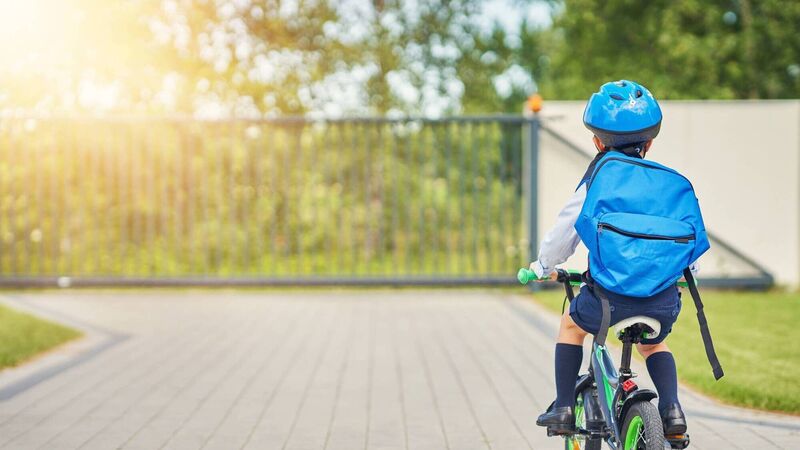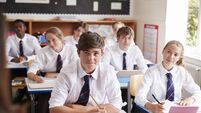Colman Noctor: Should our children wear masks to school?

Primary school children will not be required to wear masks when they return to the classroom. Picture: iStock
Primary school children will not be required to wear masks when they return to the classroom. Not everyone agrees with the Department of Education's guidance, sent out to schools last week. Concerned about the growing incidence of Covid-19, some health experts say young children should be required to wear a face mask. There are many parents who would agree.
I am a child psychotherapist, not an immunologist, and have no expertise on the pros or cons of mask wearing from a transmissibility perspective. However, where I have some degree of expertise is on the social and emotional development of children. I have spent many years studying these trajectories and feel this perspective needs to be considered when deciding on the impact of measures such as face coverings for young children.
The undeniable fact is that language and words play a central role in communication. But, tone of voice, intonation, punctuation and facial expression play a significant role too. Children learn these forms of communication through practice and interaction. These learnings occur most intensely in the formative or early years. When we learn to interpret the subtleties of communication, we begin to develop an important skillset collectively known as ‘emotional intelligence’.
The ability to interpret and appropriately express emotions such as anger, sadness, frustration, empathy and fear are all features of emotional intelligence. Many psychological experts support Daniel Goleman’s claim that emotional intelligence is a stronger predictor of life success than academic intelligence or IQ.
Our faces express much of what we feel, often more than our voices.
As we get older, we get more adept at reading facial expressions as we build on the template established in early childhood. From infancy, we learn to interpret the emotions of others and to mimic and respond appropriately. We know that a lack of stimulus with the outside world can arrest or delay mastering these skills. This learning trajectory commences steeply and levels out as we get older. This can be seen in the physiological difference between a two and 10 year old. The neurons fire at a higher rate in early childhood and so disruptions to learning opportunities are more noticeable.
The other core aspect of childhood development is emotional regulation. Already we are seeing evidence of a large proportion of children struggling to regulate their feelings. The number of childhood anxiety referrals I have received over the last year has been unprecedented. The pandemic and rolling lockdowns have taken their toll on our emotional reserves and so it has never been more important for us to scaffold and support our children’s wellbeing and protect their emotional development.
One of the most effective ways of doing this is through consistency and routine, an approach emphasised by nearly every parenting manual. Repetition allows us to form habits, develop awareness and most importantly, form trust in a reliable world. This reliability has been thrown into disarray over the past year and a half and many children have lost trust. They were initially told that school was closed for two weeks in March 2020, but they did not return until September 2020. They went on their holidays in December and didn’t see their friends and teachers again until March/ April 2021.
This disruption has chipped away at their social and emotional learning, so we need to maximise opportunities for children to experience quality emotional interaction, which includes their ability to see other people’s faces and for others to see them.
I have worked continuously over the pandemic. I have adjusted my practice to incorporate virtual sessions, social distancing sessions in larger rooms and sessions with masks. On reflection, the mask sessions are the hardest to manage. The ability to read and analyse a person’s facial expression is central to my work. It is incredibly difficult to sit with someone who is in pain and not see their full facial expression and be unable to express your empathy non verbally. Not surprisingly, some young people who come to see me have opted for virtual sessions over face-to-face sessions due to the communicative difficulties posed by face masks.
While it’s essential we prioritise our children’s health, children wearing masks is not without its risks too.
But will it have a more significant impact than catching Covid? I cannot say. Will the disruptions of possible school closures over the next year, due to increased transmission, have a greater negative impact on children than the emotional/ social cost of wearing masks? Again, I cannot say.
But what I do know is that children’s voices need to be heard in this, and their parents too. Our response to the pandemic has not worked out well for children so far. The idea that ‘the adults know best’ is only true when the adults in question explore the possible psychological impacts of physical safety measures on children.
The global pandemic is severely impacting our lives, our relationships, and our mental health. Let’s consider the two sides to every decision rather than going with the safest short-term option. A cost-benefit analysis is often the best way to come to a decision on whether something is worth pursuing or not. However, as is the case with many mental health and emotional dynamics, they can be difficult to measure and therefore the cost is underestimated. As schools reopen, I hope we keep in mind that childhood lasts a lifetime. And before we make pervasive decisions about children’s physical safety, I implore all decision makers to consider the long-term emotional impact on children too.










